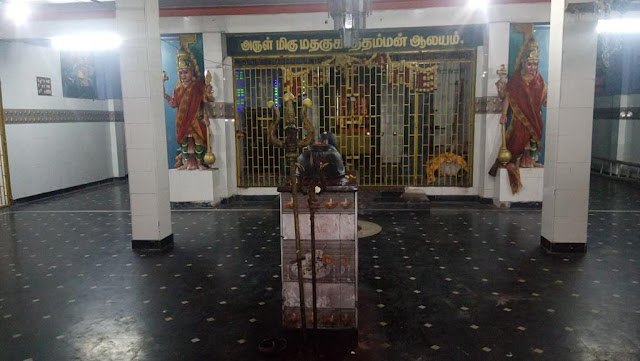Azhagiya Koothar Temple (Veera Pandiswarar Temple),
Kattarimangalam, Thoothukudi
Azhagiya Koothar Temple is a Hindu Temple dedicated to
Lord Shiva located at Kattarimangalam Village in Sathankulam Taluk in
Thoothukudi District of Tamilnadu. Presiding Deity is called as Veera
Pandiswarar and Mother is called as Nalla Thavam Nachiyar. The Temple is also
called as Veera Pandiswarar Temple. It is one of Pancha Natarajar Sthalams. Natarajar
here is called as Azhagiya Koothar. The sthapathy who created the Chidambaram
Nataraja moorthy is said to have created five Moorthies. Apart from
Chidambaram, the other four moorthies are present in the following temples
around Thirunelveli: Kari Soozhntha Mangalam, Kattarimangalam, Mela
Karuvelankulam and Chepparai.
Legends
For brief details, please refer below link;
The
Temple
There are two entrances in the Temple. One entrance is
from east and the other one is from south. But southern entrance will be open
only during festive days. Balipeedam and Nandhi house in Stone Mandapam are
found facing the Sanctum located outside the eastern entrance. Shrine for
Sangili Boothathar can be found at the right side after entering the eastern
gate.
Presiding Deity is called as Veera Pandiswarar. He is
housed in the sanctum in the form of Lingam. Small Nandhi can be found facing
the Veera Pandiswarar in the sanctum. Idols of Vinayaga and Lord Murugan can be
found at the entrance of the sanctum. Utsava idols of Somaskanda,
Piriyavidaiyaal Ambal, Manikavasagar can be found at the left side of the
sanctum.
Mother is called as Nalla Thavam Nachiyar. There are shrines for Dhakshinamoorthy, Kanni
Moolai Kanni Vinayagar, Lord Murugan with his consorts Valli and Deivanai,
Chandikeswarar, Durga, Saneeswarar and Bhairava in the Temple premises. Unusual
feature of the temple is Navagrahas graces with their consorts.
Nataraja of this Temple is called as Azhagiya Koothar
and Mother is called as Sivakami Ambal. There is a tunnel from the pond located
outside the temple to the well situated near Saneeswarar shrine. This
arrangement explains ancient technique in water harvesting. Though there are
centuries old Vanni tree and Maha Vilva in the Temple, Sthala Vriksham is
Pomegranate Tree.
Temple
Opening Time
The temple remains open from 07.00 AM to 11.00 AM and
04.30 PM to 07.00 PM.
Festivals
Sankatahara Chathurthi, Theipirai Chathurthi, Monthly
Shivarathri, Karthigai, Monthly Pournami, Margazhi Thiruvadirai and Aippasi
Thirukalyanam are the festivals celebrated here with much fanfare.
Prayers
Devotees pray to Lord to get rid of Pithru Dosha,
Navagraha Dosha, Marriage obstacles, diseases and depression. Those who want to
get married will circumbulate the temple three times and pray to Lord Shiva.
Contact
Azhagiya Koothar Temple (Veera Pandiswarar Temple),
Kattarimangalam, Sathankulam Taluk,
Thoothukudi District – 628 613
Mobile: +91 9486381956 /
9442054034
Connectivity
The Temple is located at about 3.5 Kms from Peikulam Bus
Stop, 13 Kms from Sathankulam, 15 Kms from Srivaikuntam Railway Station, 17 Kms
from Srivaikuntam, 17 Kms from Alwarthirunagari, 31 Kms from Thirunelveli, 53
Kms from Thoothukudi, 38 Kms from Thoothukudi Airport and 153 Kms from
Thiruvananthapuram Airport. There are regular buses from Thirunelveli to
Peikulam. From Peikulam, take another local bus or auto to reach this temple.







































